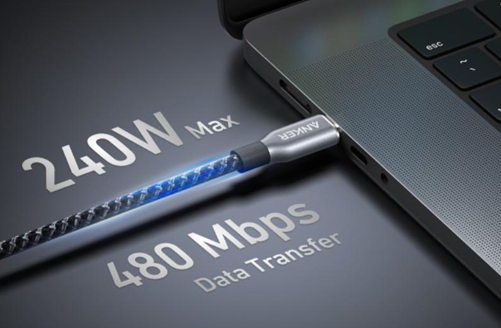Ultimate Guide to Choosing a USB-C Cable
- الصفحة الرئيسية
- مدونة
- Ultimate Guide to Choosing a USB-C Cable
Choosing the right usb c cable isn’t as straightforward as it may seem. Despite their similar appearance, USB-C cables vary greatly in terms of capabilities and compatibility. Factors such as charging speed, data transfer rates, and specific use cases play a critical role. This guide aims to demystify these elements, helping you make an informed decision. We’ll break down different types of USB-C cables, outline what to consider before making a purchase, and highlight common mistakes to avoid. Whether your goal is fast charging, quick data transfers, or high-quality video output, understanding these cables will ensure you’re getting exactly what you need.

Each USB-C cable type brings unique specifications. USB 2.0 cables are basic, typically offering data transfer speeds up to 480 Mbps. USB 3.0, on the other hand, provides faster speeds, around 5 Gbps. USB 3.1 and 3.2 ramp things up further, reaching up to 10 Gbps and even 20 Gbps, respectively. Thunderbolt 4 stands out by delivering speeds up to 40 Gbps, ideal for extensive data or video transfers. Identifying your speed needs will help you choose wisely.
Power Delivery (PD) cables are crucial when it comes to fast charging. PD cables offer higher wattage support, enabling swift charging for devices like laptops. Non-PD cables might suffice for smaller gadgets like phones but lack the capabilities for rapid charging. Consider what you’re charging to determine if a PD cable is necessary.
Check the charging speed and wattage your devices need. For high-power devices like laptops or tablets, make sure your USB-C cable supports the necessary wattage—usually indicated in the product specs. Using a cable with insufficient power delivery can slow charging or cause issues. Choosing the right cable ensures efficient charging and protects your device’s battery health.
Check your USB-C cable’s speed based on your data transfer needs. Faster speeds are essential for large file transfers and backups, reducing wait times. Also, confirm it supports required protocols—such as DisplayPort for video output—to ensure full compatibility with your devices. Choosing the right cable ensures optimal performance for both data and multimedia connections.
Identify your primary purpose—charging, data transfer, or video output—before choosing a cable. Each function may require different capabilities, and not all cables support every use. For example, a charging cable might lack video or fast data support. Selecting the right cable for your specific need ensures compatibility and performance, helping you avoid frustration and unnecessary replacements down the road.

Many assume all USB-C cables are the same, but this is a common mistake. Not all cables support the same power delivery or data transfer speeds. Choosing the wrong one can lead to poor performance or device incompatibility. Always check the specifications—such as wattage, data rate, and supported protocols—to ensure the cable meets your specific needs.
Ignoring cable length and build quality is a common mistake. A cable that’s too short or poorly made can disrupt performance and cause frustration. Opt for cables made with high-quality materials and appropriate length to ensure both durability and usability. This reduces wear and tear over time, offering a more reliable and convenient user experience.
Choose USB-C cables from reputable brands. While off-brand options may appear cost-effective, they often sacrifice quality and safety. Trusted manufacturers comply with strict standards, ensuring reliable performance and device protection. These high-quality cables are built for durability, reducing the risk of failures and replacements. Investing in known brands offers peace of mind and long-term value.
Selecting the right USB-C cable requires careful consideration of speed, wattage, and specific applications. By understanding the differences and keeping common pitfalls in mind, you can ensure compatibility, efficiency, and safety for your devices. Armed with this information, you’re now ready to make an informed choice, finding the perfect USB-C cable to meet your charging, data transfer, or video needs. Choose wisely and enjoy the reliable performance of a quality USB-C connection.